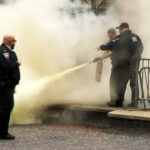
This column first ran in Valerie Monroe’s newsletter, How Not to F*ck Up Your Face, which you can subscribe to on Substack.
I recently stumbled upon a couple of side-by-side current photos of Sarah Jessica Parker looking, on the left, extremely well-preserved and on the right, like the extremely normal 60-year-old character you might find waiting to pick up her Prevacid prescription at your local CVS. The difference between the two photos was shocking; so shocking that I wondered if the un-made-up Parker photo had been fiddled with to emphasize her age. I haven’t seen Parker IRL for over 15 years, so I can’t say whether the photo was retouched. But I did see another actress at an event many years ago — an actress I adore for her brilliant work on and off the stage — and I can tell you that, though she looked spectacular on television and film, IRL she looked … well, different. Weirdly thin, frighteningly fragile, wearing one scarily neutral, unthreatening expression.
When I mentioned this in a story a while later in a post on HNTFUYF, the reader response was fierce and surprising. “How dare I criticize an actress for her aesthetic choices?” (I wasn’t exactly criticizing her or her choices.) And anyway, readers wrote, “She looks fabulous! Amazingly great for her age!” That second response confirmed that most of us still believe the images we see of the people we admire are real, when they are, for the most part, fiction.
In spite of recent observations about progress in age representation, we continue to be bombarded with images of movie stars and other often-photographed women — in their 50s, 60s, 70s, and 80s looking at least 20 years younger than they are. (Or just a whole lot better than we think we look.) In real life, few of them look very much like their photos. Photoshop, social-media filters, makeup, and props (not to mention surgery and other less-invasive treatments) all contribute to an idealized public presentation. What we’re seeing is a character they (and the photographer, makeup artist, hairstylist, and other stylists) created. It’s fun! It’s interesting! You might even think of it as performance art. But when people say they look great, that they’re a role model for looking good as we age, I find that disturbing.
Maybe you already know this. Maybe you, like me, have thought about it a lot, understand the representations are a fiction, and consider yourself sophisticated about making your own aesthetic choices. But this particular fiction has a way of sneaking up on you, pickpocketing your good sense, and leaving you bereft of the equilibrium you’ve worked so hard to earn. When surrounded by images of unrealistic beauty, you begin to internalize them, unconsciously comparing your appearance. To wit: The day after I saw the movie Barbie,my first glance in the mirror surprisingly revealed not my usual morning face — slightly creased from sleep but overall a pleasant, friendly encounter — but a face sadly and remarkably deficient in the characteristics most valued in a movie that purported to mock our unrealistic beauty culture. No longer plump, unlined, rosy, young, I was everything the movie claimed to respect yet showed only in two brief scenes. Not that I yearn to watch a movie about Barbie at 75 — or, wait, maybe I do — but staring at Margot Robbie’s perfect face for a couple of hours distorted my self-regard.
Research consistently shows that constant exposure to images of idealized beauty standards damages self-image. Doesn’t it make sense, then, that seeing representations of realistic aging might support self-esteem?
That’s why I’ve been — okay, obsessively — watching video clips of Annette Bening and Jodie Foster as they discuss their roles in Nyad and other projects. Bening, whose face clearly manifests her age — 65 — radiates confidence and composure often seen in mature women who are comfortable with themselves (or at least skillful in acting that way). And Foster, sounding 100 percent authentic, declares in interview after interview that at 60, she’s having the time of her life.
When asked, neither actress has had much to say about aesthetic work they’ve done … because there isn’t anything worth reporting (in other words, no or minimal tweakments). Foster has denied any work except lasering off hyperpigmentation (for a show that took place in the Arctic so she’d never have gotten sun exposure).
I’ve said it before, and I’ll say it again. Whatever gets you through, whatever comforts you as you clamber up the steep, rocky track to Nowhere, as the late, great Jan Morris said, is fine with me. If facial tweaking or surgery is your chosen wubby, you’ll find no judgment here. I’ll defend to the death your right to your choices. But I don’t approve of the culture that nurtures your need for them by serving up unhealthy portions of unrealistic images and infeasible objectives. A steady diet of that is toxic.
What can we do about it?
A wise old Buddhist nun and a few younger ones came upon a huge boulder. “Do you think that rock is heavy?” asked the old nun. The younger ones replied, “Of course!” The old nun laughed. “Not if you don’t pick it up,” she said.
More From This Series
- One Hairstylist’s Method for Frizzy Hair
- I Hate My Dimply Chin. Help!
Valerie Monroe , 2024-04-19 23:47:06
Source link


